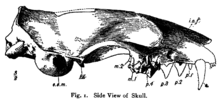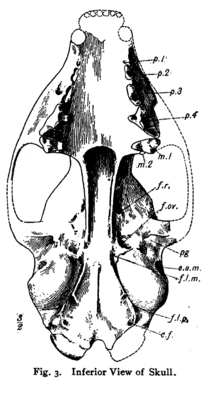Palaeogale
Palaeogale is an extinct genus of carnivorous mammal known from the Late Eocene, Oligocene, and Early Miocene of North America, Europe, and Eastern Asia. A small carnivore often associated with the mustelids, Palaeogale might have been similar to living genets, civets, and linsangs.
| Palaeogale | |
|---|---|
 | |
| Lateral view of Bunaelurus (=Palaeogale) from Matthew 1902 | |
| Scientific classification | |
| Kingdom: | Animalia |
| Phylum: | Chordata |
| Class: | Mammalia |
| Clade: | Carnivoramorpha |
| Superfamily: | †Viverravoidea |
| Genus: | †Palaeogale von Meyer 1846, p. 474 |
| Species[1] | |
| |
| Synonyms | |
| |
Time range
The ancestry of Palaeogale remains enigmatic. The genus appears in Europe 32 Ma, after the Grande Coupure, but 35-36 Ma-old (Chadronian NALMA) specimens from Pipestone Springs, Montana, are the oldest known.[2] Palaeogale survived until the late Early Miocene of Europe and the early Early Miocene of East Asia.[3]
Morlo & Nagel 2007 noted that the Palaeogale specimens found in Mongolia are the most plesiomorphic (p1 double-rooted, m2 relatively large, very small overall size) and that the genus probably originated there and migrated to Europe and North America.[3]
Anatomy
Palaeogale was the size of a small mustelid but had a hypercarnivorous dentition and its taxonomic position remains enigmatic. Its dental morphology includes both mustelid (reduced m2) and feliform (slit-like carnassial notch, loss of metaconid on m2, presence of parastyle on P4) features, and Palaeogale is typically placed in Carnivora incertae sedis.[4][5]
The body mass of Palaeogale sectoria, one of the smallest species, has been estimated to much less than a kilo based on teeth sizes. It was probably semifossorial.[6] P. sanguinarius is slightly larger than P. dorothiae and probably equivalent in age.[5]
Taxonomic history
When von Meyer 1846 named the genus Palaeogale and two species (P. pulchella and P. fecunda), he only gave a very vague description of these taxa. Gervais 1848 described a related species, Mustela minuta, which Schlosser 1888[7] thought identical and named Palaeogale minuta, a name that has remained accepted for the type species.[8]

Simpson 1946 wrote that when Cope 1873 described the North American species Bunaelurus lagophagus, he distinguished the genus from the European Plesiogale (=Palaeogale in part) based on differences in M2. Simpson, however, thought this molar was "very closely similar" in both genera and synonymized Cope's genus with Palaeogale.[9] Matthew 1902 described a skull which he referred to Cope's genus "Bunaelurus". The skull was found without lower jaws (on which all Bunaelurus specimens were based), but Matthew argued that the correspondence in horizon and size made the "identification reasonably safe." He nevertheless described it as a "Palaeogale with a minute second molar still retained."[9][10]
| Species | Time span | Size | Dental morphology |
|---|---|---|---|
| P. sectoria | Late Eocene, Early Oligocene | Medium | M2 and p1 retained |
| P. minuta | Late Oligocene, Early Miocene | Smallest | M2 and p1 lost |
| P. hyaenoides | Miocene | Medium | |
| P. dorothiae | Late Oligocene, Early Miocene | Largest |
de Bonis 1981 synonymized the then described Palaeogale species from Europe and North America into four taxa based on age occurrence, size difference, presence of M2, and loss of p1. Two species from Mongolia (P. ulysses and P. parvula) described by Matthew & Granger 1924 were synonymized by Simpson 1946[11] who argued that the smaller individuals most likely were female and the larger male members of the same species, like in modern mustelids.[4]
Flynn & Galiano 1982 created the infraorder Aeluroida to accommodate Palaeogale, Ictidopappus, and Feloidea and argued that these taxa share some derived dental features not present in other feliforms, and retain some primitive dental features that have been modified in other feliforms.[12] Flynn & Galiano, however, placed Ictidopappus as incertae sedis within this infraorder,[13] and pointed out that the grouping of Palaeogale and the Viverravidae in the superfamily Viverravoidea was a hypothetical arrangement.[14]
Baskin 1998 accepted Palaeogale as closely related to the family Viverravidae but, because it doesn't share any "unambiguous synapomorphies with either Feliforma or Caniforma", should be considered incertae sedis within Carnivora (together with Stenogale, another very small carnivoran.)[5]
References
Notes
- "Palaeogale". Fossilworks. Retrieved July 17, 2017.
- Baskin & Tedford 2005, p. 496
- Morlo & Nagel 2007, p. 228
- Hayes 2000, pp. 23–26
- Baskin 1998, p. 165
- Nagel & Morlo 2003, p. 424; Morlo & Nagel 2007, p. 227, Fig. 2; Legendre & Roth 1988
- Schlosser 1888, p. 157
- Simpson 1946, p. 2
- Simpson 1946, p. 4
- Matthew 1902, pp. 137–138
- Simpson 1946, pp. 9–11
- Flynn & Galiano 1982, p. 35
- Flynn & Galiano 1982, p. 60
- Flynn & Galiano 1982, p. 47
Sources
- Baskin, J. A. (1998). "Mustelidae". In Janis, C. M.; Scott, K. M.; Jacobs, L. L. (eds.). Evolution of Tertiary Mammals of North America: Terrestrial carnivores, ungulates, and ungulatelike mammals. 1. Cambridge University Press. pp. 152–173. ISBN 9780521355193. Retrieved October 2014. Lay summary (November 2014). Check date values in:
|accessdate=(help)CS1 maint: ref=harv (link) - Baskin, J. A.; Tedford, R. H. (2005). "Small Arctoid and Feliform Carnivorans". In Prothero, D. R.; Emry, R. J. (eds.). The Terrestrial Eocene-Oligocene Transition in North America. Cambridge University Press. ISBN 9780521021098. Retrieved November 2014. Lay summary (November 2014). Check date values in:
|accessdate=(help)CS1 maint: ref=harv (link) - de Bonis, L. G. (1981). "Contribution à l'étude du genre Palaeogale Meyer (Mammalia, Carnivora)". Annales de Paléontologie (Vertébrés). 63: 37–56. Lay summary (November 2014).CS1 maint: ref=harv (link)
- Cope, E. D. (1873). "Synopsis of New Vertebrata from the Tertiary of Colorado: Obtained During the Summer of 1873". Unclassified Publications of the U.S. Geological and Geographical Survey of the Territories.CS1 maint: ref=harv (link)
- Dehm, R. (1950). Die Raubtiere aus dem Mittel-Miocän (Burdigalium) von Wintershof-West bei Eichstätt in Bayern. Munich: Verlag der Bayerischen Akademie der Wissenschaften. OCLC 21918472.CS1 maint: ref=harv (link)
- Filhol, H. (1877). "Recherches sur les phosphorites du Quercy. Étude des fossiles qu'on y recontre et spécialement des mammifères". Annales des Sciences Géologiques, Paris. 8 (1): 1–562. Retrieved October 2014. Check date values in:
|accessdate=(help)CS1 maint: ref=harv (link) - Flynn, J. J.; Galiano, H. (1982). "Phylogeny of Early Tertiary Carnivora, With a Description of a New Species of Protictis From the Middle Eocene of Northwestern Wyoming". American Museum Novitates. 2725: 1–64. hdl:2246/5338. Lay summary (September 2014).CS1 maint: ref=harv (link)
- Gervais, P. (1848). Zoologie et paléontologie françaises (animaux vertébrés) : ou nouvelles recherches sur les animaux vivants et fossiles de la France. Paris: Arthus Bertrand. Retrieved October 2014. Check date values in:
|accessdate=(help)CS1 maint: ref=harv (link) - Hayes, F. G. (2000). "Brooksville 2 local fauna (Arikareean, latest Oligocene) Hernando County, Florida". Bulletin - Florida Museum of Natural History. 43 (1). OCLC 45207686. Retrieved October 2014. Check date values in:
|accessdate=(help)CS1 maint: ref=harv (link) - Legendre, S.; Roth, C. (1988). "Correlation of carnassial tooth size and body weight in recent carnivores (mammalia)". Historical Biology. 1 (1): 85–98. doi:10.1080/08912968809386468.CS1 maint: ref=harv (link)
- Loomis, F. B. (1932). "The small carnivores of the Miocene". American Journal of Science. 5. 24 (142): 316–329. Bibcode:1932AmJS...24..316L. doi:10.2475/ajs.s5-24.142.316.CS1 maint: ref=harv (link)
- Macdonald, J. R. (1963). "The Miocene faunas from the Wounded Knee area of western South Dakota". Bulletin of the American Museum of Natural History. 125 (3): 139–238. hdl:2246/1259. OCLC 2638176. Lay summary (October 2014).CS1 maint: ref=harv (link)
- Matthew, W. D. (1902). "On the skull of Bunaelurus, a musteline from the White River Oligocene". Bulletin of the AMNH. 16. hdl:2246/1549.CS1 maint: ref=harv (link)
- Matthew, W. D.; Granger, W. (1924). "New Carnivora from the Tertiary of Mongolia". American Museum Novitates. 104. hdl:2246/3213.CS1 maint: ref=harv (link)
- von Meyer, H. (1846). "Mittheilungen an Professor Bronn gerichtet". Neues Jahrbuch für Mineralogie, Geognosie, Geologie und Petrefaktenkunde Jahrgang 1846: 462–476. Retrieved October 2014. Check date values in:
|accessdate=(help)CS1 maint: ref=harv (link) - Morlo, M. (1996). "Carnivoren aus dem Unter-Miozän des Mainzer Beckens". Senckenbergiana Lethaea. 76 (1–2): 193–249. doi:10.1007/BF03042850. Lay summary (October 2014).CS1 maint: ref=harv (link)
- Morlo, M.; Nagel, D. (2007). "The carnivore guild of the Taatsiin Gol area: Hyaenodontidae (Creaodonta), Carnivora, and Didymoconida from the Oligocene of Central Mongolia" (PDF). Ann. Naturhist. Mus. Wien. 108: 217–231. Retrieved November 2014. Check date values in:
|accessdate=(help)CS1 maint: ref=harv (link) - Nagel, D.; Morlo, M. (2003). "Guild structure of the carnivorous mammals (Creodonta, Carnivora) from the Taatsiin Gol area, Lower Oligocene of Central Mongolia" (PDF). Deinsea. 10: 419–429. Retrieved November 2014. Check date values in:
|accessdate=(help)CS1 maint: ref=harv (link) - Schlosser, M. (1888). "Die affen, lemuren, chiropteren, insectivoren, marsupialier, creodonten und carnivoren des Europäischen Tertiärs und deren Beziehungen zu ihren lebenden und fossilen Aussereuropäischen verwandten". Beiträge zur Paläontologie Österreich-Ungarns und des Orients. 7 (1–2): 1–224. OCLC 488976994. Retrieved November 2014. Check date values in:
|accessdate=(help)CS1 maint: ref=harv (link) - Simpson, G. G. (1946). "Palaeogale and allied early mustelids". American Museum Novitates. 1320. hdl:2246/2311. Lay summary (November 2014).CS1 maint: ref=harv (link)